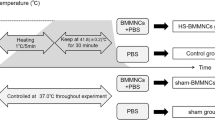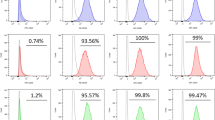Abstract
We have investigated the effects of thermal injury upon myelopoiesis. IL-3, GM-CSF, and IL-5 were used to stimulate myeloid colony formation. IL-3 induces early myeloid progenitors and a more developed myeloid progenitor, the granulocyte-macrophage colony-forming unit (GM-CFU), to multiply and develop into mature myeloid cells. GM-CSF induces GM-CFU to become mature myeloid cells, while IL-5 induces eosinophil progenitors to become mature eosinophils. Stem Cell Factor (SCF) + IL-6 and FLT3 ligand, which have no effect on colony formation by themselves, were used to enhance the effects of IL-3 and GM-CSF, respectively. We found that thermal injury increased the number of early myeloid progenitors and GM-CFU in the spleen with either IL-3 or GM-CSF as a stimulant. Thermal injury increased the number of early myeloid progenitors in the bone marrow when GM-CSF, but not IL-3, was used to stimulate colony growth. Also, thermal injury increased the numbers of eosinophil progenitors in rat spleen and bone marrow and increased splenic levels of IL-5 mRNA.
Similar content being viewed by others
References
Lyman, S. D. and S. E. Jacobsen. 1998. C-kit ligand and FLT3 ligand:stem/progenitor cell factors with overlapping yet distinct activities. Blood 91:1101–1134.
Leenen, P. J. M. and F. T. R. Debruijn. 1997. Murine Myelopoeisis. Imm. Today.
Kurata, H., T. Arai, T. Yokata, and K. Arai. 1995. Differential expression of granulocyte macrophage colony-stimulating factor and IL-3 receptor subunits on human CD34+ cells and leukemic cell lines. J. Allergy Clin. Immunol. 96:1083–1099.
Bedi, A. and S. J. Sharkis. 1995. Mechanisms of cell commitment in myeloid cell differentiation. Curr. Op. Hematol. 2:12–21.
Shurin, M. R., C. Esche, and M. T. Lotze. 1998. FLT3: receptor and ligand. Biology and potential clinical application. Cytokine Growth Factor Rev. 9:37–48.
Broxmeyer, H. E., L. Lu, S. Cooper, L. Ruggieri, Z. H. Li, and S. D. Lyman. 1995. Flt3 ligand stimulates/costimulates the growth of myeloid stem/progenitor cells. Exp. Hematol. 23:1121–1129.
McNiece, I. K. Synergism of hematopoietic colony-stimulating factors. 1992. Am. J. Ped. Hem./Oncol. 14:31–38.
Tanaka, N. Katayama, K. Ohishi, et al. 1995. Accelerated cellcycling of hematopoietic progenitor cells by growth factors. Blood. 86:73–79.
Gabrilove, J. L. Introduction and overview of hematopoietic growth factors. 1989. Semin. Hematol. 26:1–4.
Ishihara, K., T. Nittoh, I. Satoh, and K. Ohuchi. 1999. Analysis of biological activities of recombinant rat interleukin-5. Int. Arch. Allergy Immunol. 120:11–14.
Ishihara, K., I. Satoh, S. Mue, and K. Ohuchi. 2000. Generation of rat eosinophils by recombinant rat interleukin-5 in vitro and in vivo. Biochimca et. Biophysica Acta. 1501:25–32.
Clutterbuck, E. J., E. M. Hirst, and C. J. Sanderson. 1989. Human interleukin-5 (IL-5) regulates the production of eosinophils in human bone marrow cultures: comparison and interaction with IL-1, IL-3, IL-6, and GMCSF. Blood. 73:1504–1512.
Wallner, S., R. Vautrin, J. Murphy, S. Anderson, and V. Peterson. 1984. The haematopoietic response to burning: studies in an animal model. Burns. 10:236–251.
Gamelli, R. L., J. C. Herbert, and R. S. Foster. 1985. Effect of burn injury on granulocyte and macrophage production. J. Trauma. 25:615–619.
Gruber, D. F. and A. M. Farese. 1989. Bone marrow myelopoiesis in rats after 10%, 20%, or 30% thermal injury. J. Burn Care Rehabil. 10:410–417.
Burgess, A. W. and D. Metcalf. 1980. The nature and action of granulocyte-macrophage colony stimulating factors. Blood. 56:947–958.
Broxmeyer, H. E. Suppressor cytokines and regulation of myelopoiesis. 1992. Am. J. Ped. Hem./Oncol. 14:22–30.
Ikebuchi, K., G. G. Wong, S. C. Clark, J. N. Ihle, Y. Hirai, and M. Ogawa. 1987. Interleukin 6 enhancement of interleukin 3-dependent proliferation of multipotential hemopoietic progenitors. Proc. Natl. Acad. Sci. 84:9035–9039.
Huang, W. H., J. Z. Wu, Z. X. Hu, S. Z. Feng, X. Y. Huang, and A. Li. 1988. Bone marrow granulopoietic response to scalds and wound infection in mice. Burns. 14:292–296.
Santangelo, R. L. Gamelli, and R. Shankar. 2001. Myeloid commitment shifts toward monocytopoiesis after thermal injury and sepsis. Ann. Surg. 233:97–106.
Tang, Y., R. Shankar, M. Gamboa, S. Desai, R. L. Gamelli, and S. B. Jones. 2001. Norepinephrine modulates myelopoiesis after experimental thermal injury with sepsis. Ann. Surg. 233:266–275.
Koike, M. and K. Takatsu. 1994. IL-5 and its receptor: which role do they play in the immune response. Int. Arch. Allergy Immunol. 104:1–9.
Menon, T., T. Sundararaj, and S. Subramanian. 1990. Kinetics of peripheral blood leukocyte counts in patients following thermal injuries. Indian J. Pathol. Microbiol. 33:372–374.
Wong, D. T., R. B. Donoff, J. Yang, et al. 1993. Sequential expression of transforming growth factors alpha and beta 1 by eosinophils during cutaneous wound healing in the hamster. Am. J. Pathol. 143:130–142.
Todd, R., B. R. Donoff, T. Chiang, et al. 1991. The eosinophil as a cellular souce of transforming growth factor alpha in healing cutaneous wounds. Am. J. Pathol. 138:1307–1313.
Yukawa, T. 1993. Eosinophil-derived collagenase (metalloproteinase). Nippon Rinsho. 51:643–650.
Hibbs, M. S., C. L. Mainardi, and A. H. Kang. 1982. Type-specific collagen degradation by eosinophils. Biochem. J. 207:621–624.
Yang, J., A. Torio, R. B. Donoff, et al. 1997. Depletion of eosinophil infiltration by anti-IL-5 monclonal antibody (TRFK-5) accelerates open skin wound epithelial closure. Am. J. Pathol. 151:813–819.
Author information
Authors and Affiliations
Rights and permissions
About this article
Cite this article
Noel, J.G., Wells, D.A., Guo, X. et al. Thermal Injury Increases the Number of Eosinophil Progenitors in Rat Spleen and Bone Marrow. Inflammation 25, 339–349 (2001). https://doi.org/10.1023/A:1012836001062
Issue Date:
DOI: https://doi.org/10.1023/A:1012836001062




